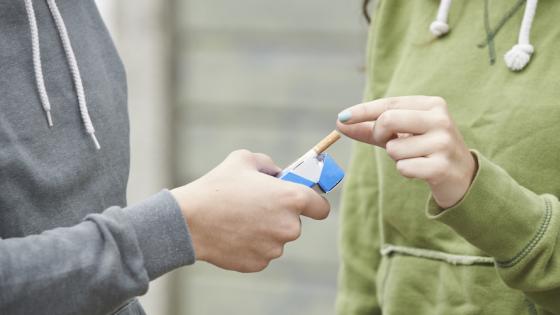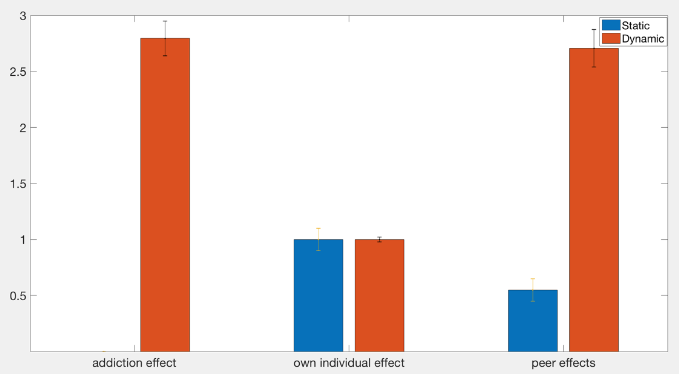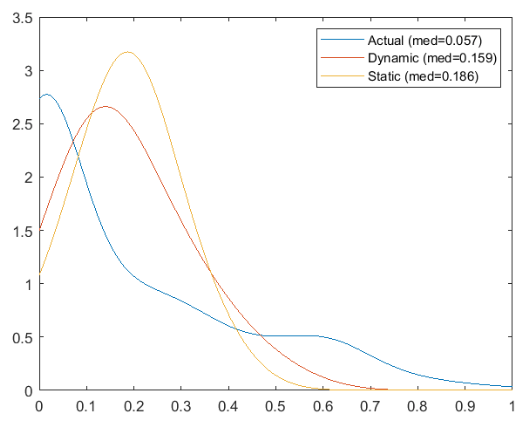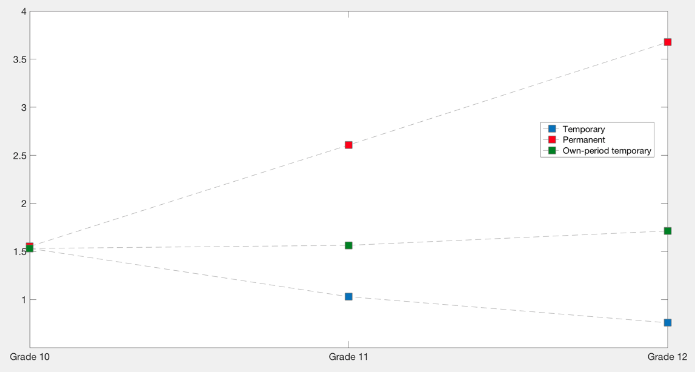Smoking and alcohol use are widespread among adolescents in the US. According to the 2018 National Youth Tobacco Survey, more than one in four high school students and about one in 14 middle school students had used a tobacco product in the past 30 days. Smoking and alcohol are a serious policy concern in that they involve severe risks in health outcomes and have large socioeconomic costs (e.g. poor academic performance, reduced earnings and employment, and criminal victimisation).
A large literature in economics, and in the social sciences more generally, studies the risky health behaviour of adolescents to understand what motivates it and to design policies to curb it. Two fundamental insights in this literature are that most manifestations of such risky behaviour, including smoking and alcohol use: (i) have a dynamic component, for instance because they are addictive; and (ii) are social, in the sense that they depend on the behaviour of relevant peers (see Cawley and Ruhun 2011 for extensive reviews).
The majority of the studies have dealt separately with dynamic and social components of adolescent risky behaviour. However, the joint consideration of dynamic choice and social interactions highlights interesting novel dimensions of risky behaviour and hence new questions to address.
For instance, when an adolescent considers smoking or drinking, does he/she anticipate how the addictive effects of such behaviour spread through their network of friends? When an adolescent selects a friend network, does he/she anticipate the dynamics of the group’s behaviour with respect to risky behaviour? Does an anticipated change in the social network, e.g. after high-school, affect the importance of peer effects on risky behaviour across the schooling age?
In our recent paper (Arduini et al. 2019), we formulate and estimate a dynamic social interactions model to answer some of these questions. In particular, the model embeds the dynamic choice of adolescents regarding alcohol and smoking in a school environment characterised by rich social interactions. We bring the model to data in the context of students’ school networks included in the Add Health dataset.1 The social and dynamic interaction effects jointly allow us to exploit the intertemporal linkages formed by the moment restrictions of dynamic equilibrium of our social interactions model, including network fixed effects, and to add a Heckman-correction term to the structural equations to control for selection into networks.
Adolescent risky behaviours are driven by individual preferences, addiction effects, and peer effects (via preference for conformity); the discount rate represents the forward-looking aspect of individual choice. The empirical analysis confirms that students are forward-looking (the discount rate is positive and significant) and that both addiction effect and peer effects are fundamental in explaining risk behaviour. Both addiction and peer effects are more than twice as important as the individual effect (see Figure 1).
Figure 1 Estimates of the structural parameters under different model specifications
Notes: Figure 1 reports GMM estimates of the dynamic social interaction model as well as of the (misspecified) static model (with neither addiction nor forward-looking behaviour). The individual-preference effect is normalised to 1.
Indeed, a (misspecified) static model with neither addiction nor forward-looking behaviour would produce a sizeable bias, largely underestimating the relevance of peer effects in the students’ choices.
The static model also does not predict as accurately as the dynamic social interaction model (Figure 2). The correlation between actual and predicted choices is 0.32 for the dynamic model and only 0.06 for the static model.
Figure 2 Distributions of actual and predicted values of the risky behaviour index
Notes: Figure 2 compares the fit of the dynamic social interaction model and the (misspecified) static model. It plots the empirical distributions of the actual data and the predictions that are obtained when using the two different models.
The empirical analysis also provides evidence that the network of friends is endogenous – that is, the students’ selection of their friend network is not independent of unobserved characteristics, which in turn might lead them to risky behaviour. Neglecting to control for the endogeneity of the social network leads to a large significant downward bias in the estimate of addiction effects and an upward bias in the estimate of conformity effects (peer effects).
Figure 3 Estimates of the structural parameters under endogenous and exogenous network
Notes: Figure 3 reports our baseline parameter estimates of the dynamic social interaction model (as in Figure 1), which control for network endogeneity adding a Heckman-correction term for selection, as well as the parameter we would obtain treating the network as exogenous. The individual-preference effect is normalised to 1.
A summary quantitative measure of the effects of addiction and peers on adolescent risky behaviour is given by the social multiplier. Consider a temporary (one school year) increase in a student’s preferences for risky behaviour in 10th grade. We normalise the direct effect of this shock on his/her behaviour in the same grade; say it induces an increase of one of the risky behaviour index. Accounting now for peer effects (the effects of this shock spread to the student’s network and then back to the student him/herself) and addiction effects (which induces a future increase in risky behaviour), the resulting total effect (a multiplying factor) is the social multiplier.
According to the estimates in Arduini et al. (2019), the social multiplier of a temporary shock in the 10th grade is 1.53 in the same 10th grade, 1.03 in the 11th grade, and 0.76 in the 12th grade. The multiplier of a permanent shock in grades 10, 11, and 12 is very large, at 1.55, 2.6, and 3.68, respectively.
Interestingly, the same-period multiplier effect of a temporary shock in the different grades encodes the importance in students’ choice of the number of periods left until the end of school: the social multiplier of a temporary shock in grade 12 (the last year of high school) on behaviour in the same grade is about 1.7, whereas it is 1.56 and 1.53, respectively, in grades 11 and 10. Students anticipate a change in their social network after high school and this affects the importance of peer effects over schooling age: the longer the time left until the end of high school, the more heavily students weigh the future. Thus, the current shock has a smaller effect.
Figure 4 Estimates of the social multiplier effects
Notes: Figure 4 reports estimates of the social multiplier effects under temporary and permanent shocks across grades.
These results have notable policy implications. Where social interactions are quantitatively important, well-targeted policy interventions at a smaller scale might have much larger effects in the aggregate through the social multiplier. The misspecified static model underestimates the relative relevance of peer effects in explaining the risky behaviour of adolescents. It induces much smaller social multipliers and hence would underestimate the effects of small-scale policy interventions. Furthermore, a static model does not account for policy interventions affecting adolescents’ risky behaviour in the future.
References
Arduini, T, A Bisin, O Özgür and E Patacchini (2019), “Dynamic social interactions and health risk behavior”, NBER Working Paper w26223.
Cawley, J, and C J Ruhm (2011), “The economics of risky health behaviors”, in M V Pauly, T G Mcguire and P P Barros (eds.), Handbook of Health Economics, Vol. 2, North-Holland: Elsevier.
Gentzke, A S, M Creamer, K A Cullen, et al. (2019), “Vital signs: Tobacco product use among middle and high school students — United States, 2011–2018”, CDC Morbidity and Mortality Weekly Report 68(6): 157–64.
Endnotes
[1] The data collected by this survey include information about each student’s health-risk behaviour as well as his/her social network, repeatedly in distinct school years. We construct an index of risky behaviour by first standardising cigarette and alcohol consumption in [0,1] and then averaging. A higher value of the index is interpreted as a riskier health choice.








